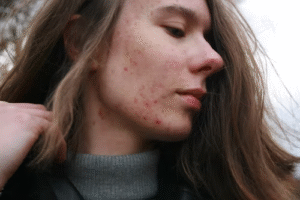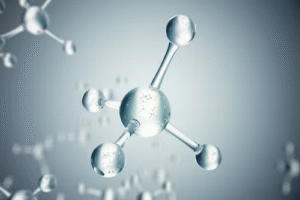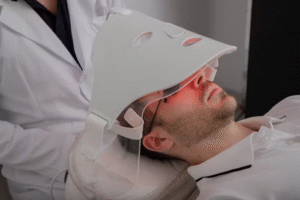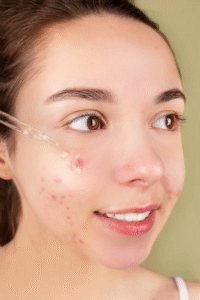
Social media, or modern media in general, has changed the public perception of an athlete. Nowadays, brands are reaching out to sports athletes for brand endorsements; the pressure for them to look photo-ready is higher than ever. However, with constant outdoor exposure in the sun and dust, athletes are prone to breakouts and acne.
The medical term for this type of acne is ‘acne mechanica.’ It is common among sports athletes. It occurs when you wear tight clothes, combined with heavy sweating or chafing, leading to irritated skin, itchiness, and redness.
Acne can be seen in both men and women and at any age (ideally 11 to 30). Usually teenagers experience acne because of hormonal changes. For women, conditions like PCOS, PCOD, and pregnancy are significant factors for acne.
According to the report, acne in women with PCOS ranges between 40% and 60%, with an average of 49%. Some studies show around 9% of female athletes are diagnosed with PCOS; additionally, attributes like excessive exercise, lifestyle, and lower BMI can contribute to hormonal changes like PCOS.
Quick Note: Phage therapy for acne is not a new concept; it existed in the mid-20th century, when people were commonly affected by acne. However, due to a lack of laboratories at the time, slowly the focus shifted to antibiotics. Bacteriophage therapy can be applied pre- and post-training sessions, but they are unlikely with the anti-doping policies. Proper guidelines and regulatory policy clarity are essential for elite athletes.
Despite the success of bacteriophage therapy in early stages of acne treatment, it becomes difficult for the athletes to maintain results post-treatment due to outdoor training. In this article, we will discuss some of the best ways to treat acne as an athlete, and I will share my personal journey with acne and effective methods I used to get rid of acne as an athlete.
Note: As teenagers we neglect the skincare. Skincare is essential for teen athletes too. You can click on the link to learn more about it.
Common Types of Acne Athletes Suffer
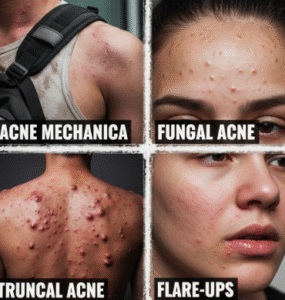
- Acne Mechanica: This type of acne is mostly found in sports athletes. It can occur due to chafing, friction, and heat. According to a global survey, around 25% of the athletes suffer from this type of acne.
- Fungal Acne: This occurs due to the overgrowth of yeast, leading to itchiness and redness. A survey of 1075 athletes suspected of having 3.3% of Malassezia furfur and Pityrosporum ovale, which are types of fungal acne.
- Truncal Acne: It happens a lot with swimmers due to significant exposure to chlorine. According to a survey, 30% to 60% of people are affected by truncal acne around the back and chest region, and less than 1% to 14% are affected around the face.
- Flare-ups: Often triggered by heavy sweat production and cortisol fluctuations.
What Causes Acne in Athletes (Men and Women)?
- Stress and hectic training schedules
- Hormonal changes like PCOS, PCOD, irregular periods, pregnancy
- Lifestyle changes
- Genetics
- Improper shaving techniques
- Taking medications containing lithium, steroids, corticosteroids
- Prolong sun exposure
- Certain cosmetic products can clog your pores, resulting in acne
- Excess sweat and oil production
- Friction and chafing from sports equipment
- Heat
- Supplement Use: Taking high doses of vitamin B6 and B12 supplements has been reported to worsen the acne. A survey report on escholarship.org indicates that females are more susceptible to breakouts due to B1, B6, and B12 supplements than males in the long period of time.
What Are the Best Potential Acne Treatments for the Athletes?
Here are some of the best treatments for the athletes’ acne.
1. Benzoyl Peroxide:
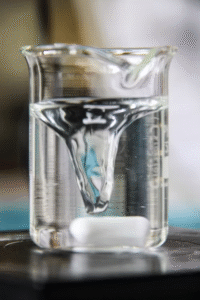
It is a low-concentration organic acid that, when applied to skin, breaks down into benzoic acid; this, in turn, lowers the skin pH level and creates a mild acidic environment. This can reduce bacteria causing acne or rosacea and minimize the inflammation caused by acne.
Note: Benzoyl peroxide can be irritating on acne-prone or sensitive skin, and it may leave your skin dry. It is recommended to start with a low concentration of benzoyl peroxide until your skin adjusts, and you can slowly increase the concentration if needed. Available concentrations range from 2.5% to 10%.
Product Examples: A few cleansers/face washes with benzoyl peroxide are:
- PanOxyl Acne Foaming Wash (often 10% concentration)
- CeraVe Acne Foaming Cream Cleanser (often 4% concentration)
- Differin Daily Deep Cleanser (often 5% concentration)
- Cetaphil Gentle Clear Complexion-Clearing BPO Acne Cleanser (often 2.6% concentration)
Acne creams with benzoyl peroxide:
PERSA-GEL 10
- La Roche-Posay Effaclar Duo Acne Treatment (often 5.5% concentration)
- Neutrogena Stubborn Acne AM Treatment (often 2.5% concentration)
- Clean & Clear PERSA-GEL 10 Acne Medication (often 10% concentration)
2. Retinoids:
“Retinoids“ is an umbrella category for vitamin A derivatives.
- Stronger retinoids are retinoic acid (or tretinoin)
- Lower concentrations of retinoids are OTC (over the counter).
When comparing OTC types —
- Retinol has gentle retinoic acid.
- Retinal (retinaldehyde) is a stronger form of retinoic acid.
Product Examples: A few retinol products in India:
- Minimalist 0.3% Retinol Face Serum
- Dot & Key Night Reset Retinol + Ceramide Cream
- The Derma Co 0.3% Retinol Serum
- Plum 1% Retinol Face Serum
A few retinal products in India:
- E.l.f. Youth Busting Advanced Night Retinoid Serum
- Naturium Retinaldehyde Cream Serum 0.05%
- Skinbetter Science AlphaRet Overnight Cream
- Peach & Lily Retinal for All Renewing Serum
3. Salicylic Acid:
It is a beta-hydroxy acid, which acts as a keratolytic agent and helps in clearing the acne and dead skin.
Product Example: A few salicylic acid serums are
- The Derma Co 2% Salicylic Acid Serum
- Minimalist 2% Salicylic Acid Serum
- Novology Acne Clearing Serum
A few salicylic acid face washes are
- Minimalist 2% Salicylic Acid Face Wash
- The Derma Co Sali-Cinamide Face Wash
Acne treatment cream:
- Sebogel Salicylic Acid & Nicotinamide Gel
4. Probiotics:
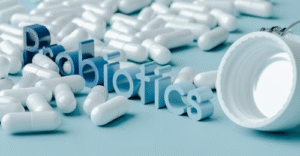
Taking probiotics helps kill bad gut bacteria, which quickly get replaced by good ones, so it prevents the bad bacteria from returning. Using a probiotic regularly will keep your gut clean and improve immunity.
5. Prescribed Prescription:
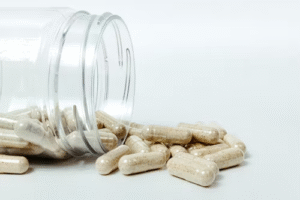
Oral medications like antibiotics prescribed by dermatologists can help you get rid of acne.
6. Dermatologist Prescription:
Lasers, chemical peeling, and facial procedures are a few options that dermatologists may recommend to treat acne.
7. Lifestyle:
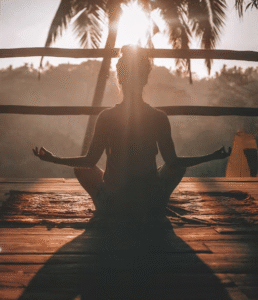
Athletes have a hectic and stressful lifestyle, due to which they can come across acne and breakouts. Sleep, food, and water are very essential for an athlete. What you intake will reflect on your skin. Carbohydrates, sugar, and dairy (skim milk) are high-glycemic foods that can stimulate breakouts and acne. Being careful about your lifestyle, food, and sleep can help you achieve clear skin in the long run.
Does Steroid Acne in Athletes Go Away?
Yes, steroid-induced acne can go away if you discontinue the use of steroids. It might take a few weeks or months. You can consider treatments like taking oral medications, antifungal medications, antibiotics, and anti-acne creams. If you are suffering from severe acne, then consult a dermatologist.
What Will 100% Get Rid of Acne in Athletes?
There is no 100% guaranteed treatment to get rid of acne. However, there are few ways that can help you to get rid of acne and achieve clear skin to some extent. Using dermatologist-approved skincare for athletes can help you achieve clearer and better skin, like laser treatment, chemical peeling, oral medication, and using retinoids (tretinoin and adapalene).
Personal Opinion:
As an athlete with PCOS, I have struggled with persistent acne. I tried numerous solutions, and nothing worked 100%. However, I found a regimen that helped me clear most of my acne and acne scars. Here are a few things that have worked for me.
- Laser Treatment: Initially, my first attempt was laser treatment. Unfortunately, it caused me more redness and breakouts.
- Chemical Peeling: Next, I tried chemical peeling, and this was a game changer. It helped me clear 95% of the acne, though some minor acne and breakouts returned a few months later.
- Retinol: I tried OTC retinol serum, which helped me fade the remaining acne and acne scars and significantly reduced the redness.
- Final Skincare Routine: To get back the glowing skin, I started using vitamin C serum with the sunscreen, a winning combination as part of the morning regime, and a night regime of retinol with a thick layer of gel-based moisturizer.
- Foundation (lifestyle): Most importantly, i focused on lifestyle changes and consistent proper sleep, balanced diet, stress management, hot showers,
Final thoughts:
Skincare has evolved from an occasional luxury to becoming an essential part of the routine for both men and women. The Indian beauty and personal care market is projected to reach around $34 billion by 2028. The skincare and makeup industry is growing by 25% every year, at an average of 4.3%, while the acne skincare industry is projected to grow to ₹505 crore by 2030 with a growth rate of 10.3%. While many skincare products exist, the real challenge is finding what works best for you.
Beyond the products, consistency is important. Simple routine, eating healthy, sleep, less stress, and avoiding reusing sweaty towels.

